Analyzing Network Stack Layers, Addressing Techniques & Architectures
VerifiedAdded on 2023/06/13
|9
|1833
|260
Homework Assignment
AI Summary
This assignment delves into the fundamental concepts of data communication, beginning with an examination of the network stack, focusing on the physical, data link, and internet layers. It details the functions of each layer, including bit-level transmission, data encoding/decoding, and IP-based data packet routing. The assignment also covers Boolean operations on bit patterns and subnet masking techniques, illustrating how to calculate subnet masks and identify legal address masks. Furthermore, it compares controlled access and contention-based access methods to physical mediums, highlighting the differences between centralized and distributed systems. The document concludes with a comparison of switched, routed, and collapsed backbone architectures, emphasizing the role of VLANs in enhancing network performance. Desklib provides access to this and other solved assignments, offering students comprehensive study tools and resources.
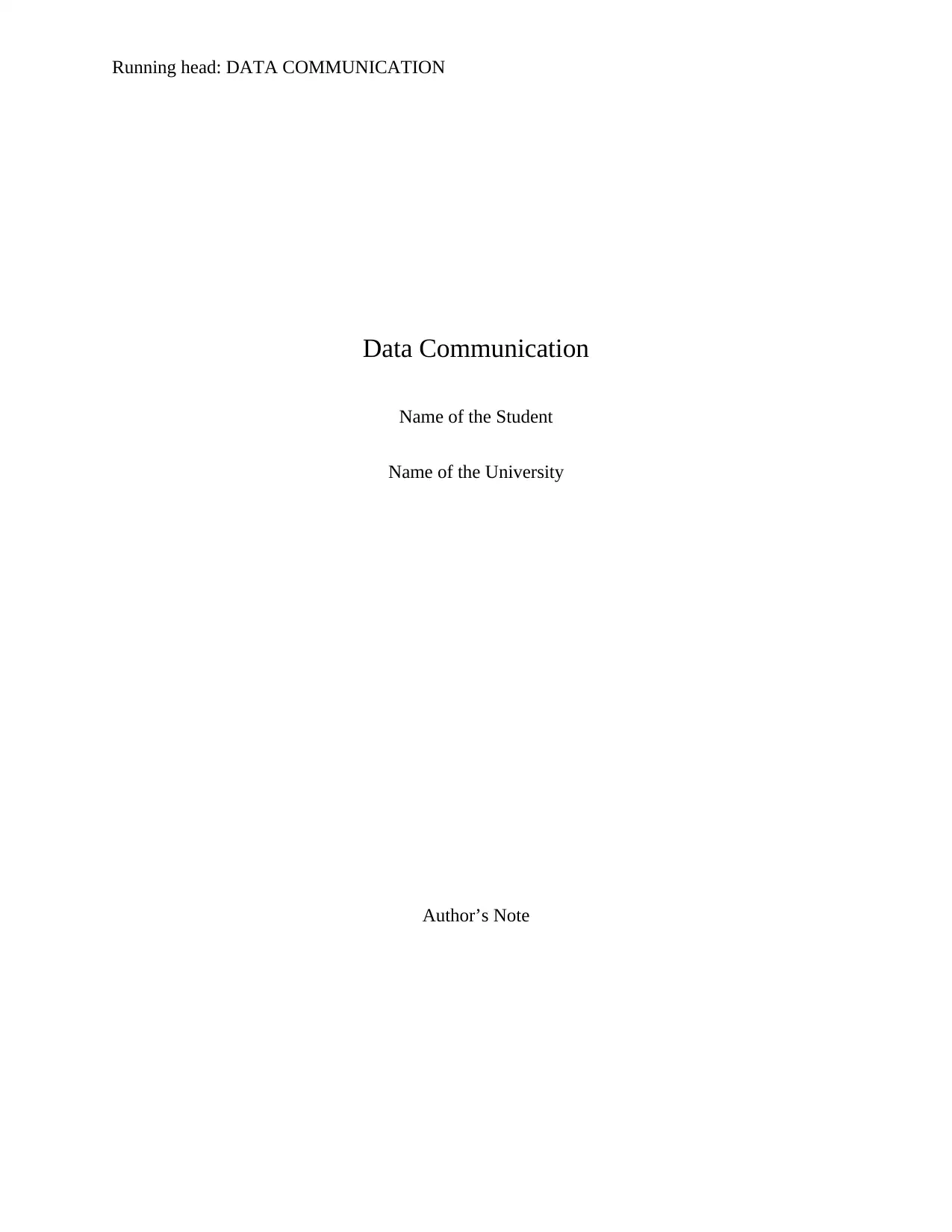
Running head: DATA COMMUNICATION
Data Communication
Name of the Student
Name of the University
Author’s Note
Data Communication
Name of the Student
Name of the University
Author’s Note
Paraphrase This Document
Need a fresh take? Get an instant paraphrase of this document with our AI Paraphraser
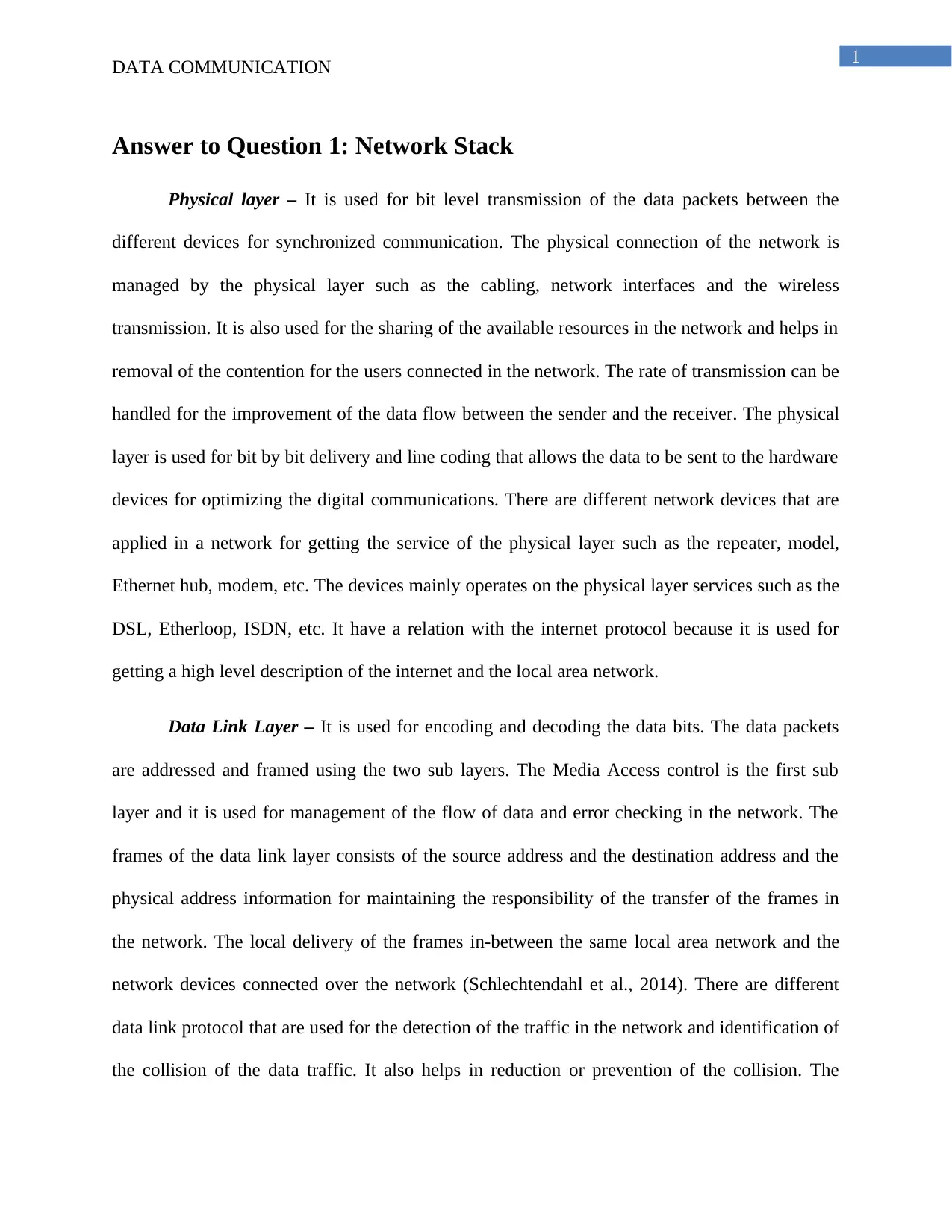
1
DATA COMMUNICATION
Answer to Question 1: Network Stack
Physical layer – It is used for bit level transmission of the data packets between the
different devices for synchronized communication. The physical connection of the network is
managed by the physical layer such as the cabling, network interfaces and the wireless
transmission. It is also used for the sharing of the available resources in the network and helps in
removal of the contention for the users connected in the network. The rate of transmission can be
handled for the improvement of the data flow between the sender and the receiver. The physical
layer is used for bit by bit delivery and line coding that allows the data to be sent to the hardware
devices for optimizing the digital communications. There are different network devices that are
applied in a network for getting the service of the physical layer such as the repeater, model,
Ethernet hub, modem, etc. The devices mainly operates on the physical layer services such as the
DSL, Etherloop, ISDN, etc. It have a relation with the internet protocol because it is used for
getting a high level description of the internet and the local area network.
Data Link Layer – It is used for encoding and decoding the data bits. The data packets
are addressed and framed using the two sub layers. The Media Access control is the first sub
layer and it is used for management of the flow of data and error checking in the network. The
frames of the data link layer consists of the source address and the destination address and the
physical address information for maintaining the responsibility of the transfer of the frames in
the network. The local delivery of the frames in-between the same local area network and the
network devices connected over the network (Schlechtendahl et al., 2014). There are different
data link protocol that are used for the detection of the traffic in the network and identification of
the collision of the data traffic. It also helps in reduction or prevention of the collision. The
DATA COMMUNICATION
Answer to Question 1: Network Stack
Physical layer – It is used for bit level transmission of the data packets between the
different devices for synchronized communication. The physical connection of the network is
managed by the physical layer such as the cabling, network interfaces and the wireless
transmission. It is also used for the sharing of the available resources in the network and helps in
removal of the contention for the users connected in the network. The rate of transmission can be
handled for the improvement of the data flow between the sender and the receiver. The physical
layer is used for bit by bit delivery and line coding that allows the data to be sent to the hardware
devices for optimizing the digital communications. There are different network devices that are
applied in a network for getting the service of the physical layer such as the repeater, model,
Ethernet hub, modem, etc. The devices mainly operates on the physical layer services such as the
DSL, Etherloop, ISDN, etc. It have a relation with the internet protocol because it is used for
getting a high level description of the internet and the local area network.
Data Link Layer – It is used for encoding and decoding the data bits. The data packets
are addressed and framed using the two sub layers. The Media Access control is the first sub
layer and it is used for management of the flow of data and error checking in the network. The
frames of the data link layer consists of the source address and the destination address and the
physical address information for maintaining the responsibility of the transfer of the frames in
the network. The local delivery of the frames in-between the same local area network and the
network devices connected over the network (Schlechtendahl et al., 2014). There are different
data link protocol that are used for the detection of the traffic in the network and identification of
the collision of the data traffic. It also helps in reduction or prevention of the collision. The

2
DATA COMMUNICATION
physical address of the device connected in the network for establishment of the connection and
it can be used for the identification of the source of the data and control the errors with the
implementation of the FEC and the ARQ technique.
Internet layer – It consists of different protocols, specification and internetworking
methodology that are used for transferring the datagram packets from the hosts to the network
boundaries. IP based data packets are used for transmission of the data packets to the destination
address. The internet layer is responsible for maintaining the security of the network and it also
maintains the compatibility and the scalability of the network (Iskander et al., 2016). Both the
connection oriented and the connection less service are provided by the internet layer because it
supports the TCP and UDP protocol for transferring the data packets in the network. The
reliability of the packet are maintained by the TCP protocol and the IPSec is used for the IP
communication. It also uses the cryptographic key and the internet group management protocol
is used for the IPv4 hosts and the multicast routers to establish the connection between the group
(Mekonnen, Tangdiongga & Koonen, 2015). The main purpose of the internet layer is to transmit
the data packet to the appropriate layer for sending it to the destination address and it also
provides detection of the errors and diagnosis of the capability.
Answer to Question 2: Drills
a. Boolean Operation of the bit patterns
i. not 0010111000101100
= 1101000111010011
ii. 0010111000101100 or 1110000011100001
DATA COMMUNICATION
physical address of the device connected in the network for establishment of the connection and
it can be used for the identification of the source of the data and control the errors with the
implementation of the FEC and the ARQ technique.
Internet layer – It consists of different protocols, specification and internetworking
methodology that are used for transferring the datagram packets from the hosts to the network
boundaries. IP based data packets are used for transmission of the data packets to the destination
address. The internet layer is responsible for maintaining the security of the network and it also
maintains the compatibility and the scalability of the network (Iskander et al., 2016). Both the
connection oriented and the connection less service are provided by the internet layer because it
supports the TCP and UDP protocol for transferring the data packets in the network. The
reliability of the packet are maintained by the TCP protocol and the IPSec is used for the IP
communication. It also uses the cryptographic key and the internet group management protocol
is used for the IPv4 hosts and the multicast routers to establish the connection between the group
(Mekonnen, Tangdiongga & Koonen, 2015). The main purpose of the internet layer is to transmit
the data packet to the appropriate layer for sending it to the destination address and it also
provides detection of the errors and diagnosis of the capability.
Answer to Question 2: Drills
a. Boolean Operation of the bit patterns
i. not 0010111000101100
= 1101000111010011
ii. 0010111000101100 or 1110000011100001
⊘ This is a preview!⊘
Do you want full access?
Subscribe today to unlock all pages.

Trusted by 1+ million students worldwide
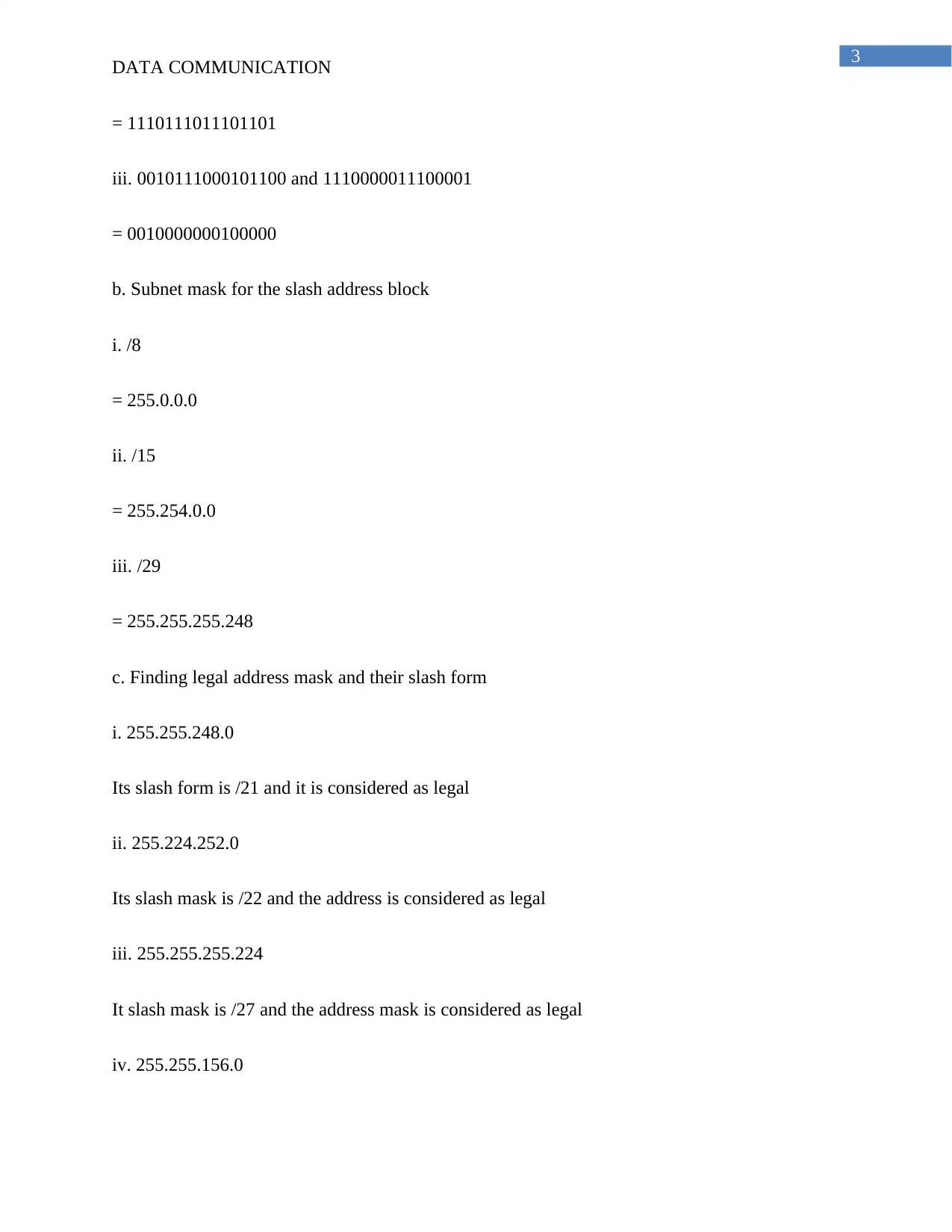
3
DATA COMMUNICATION
= 1110111011101101
iii. 0010111000101100 and 1110000011100001
= 0010000000100000
b. Subnet mask for the slash address block
i. /8
= 255.0.0.0
ii. /15
= 255.254.0.0
iii. /29
= 255.255.255.248
c. Finding legal address mask and their slash form
i. 255.255.248.0
Its slash form is /21 and it is considered as legal
ii. 255.224.252.0
Its slash mask is /22 and the address is considered as legal
iii. 255.255.255.224
It slash mask is /27 and the address mask is considered as legal
iv. 255.255.156.0
DATA COMMUNICATION
= 1110111011101101
iii. 0010111000101100 and 1110000011100001
= 0010000000100000
b. Subnet mask for the slash address block
i. /8
= 255.0.0.0
ii. /15
= 255.254.0.0
iii. /29
= 255.255.255.248
c. Finding legal address mask and their slash form
i. 255.255.248.0
Its slash form is /21 and it is considered as legal
ii. 255.224.252.0
Its slash mask is /22 and the address is considered as legal
iii. 255.255.255.224
It slash mask is /27 and the address mask is considered as legal
iv. 255.255.156.0
Paraphrase This Document
Need a fresh take? Get an instant paraphrase of this document with our AI Paraphraser
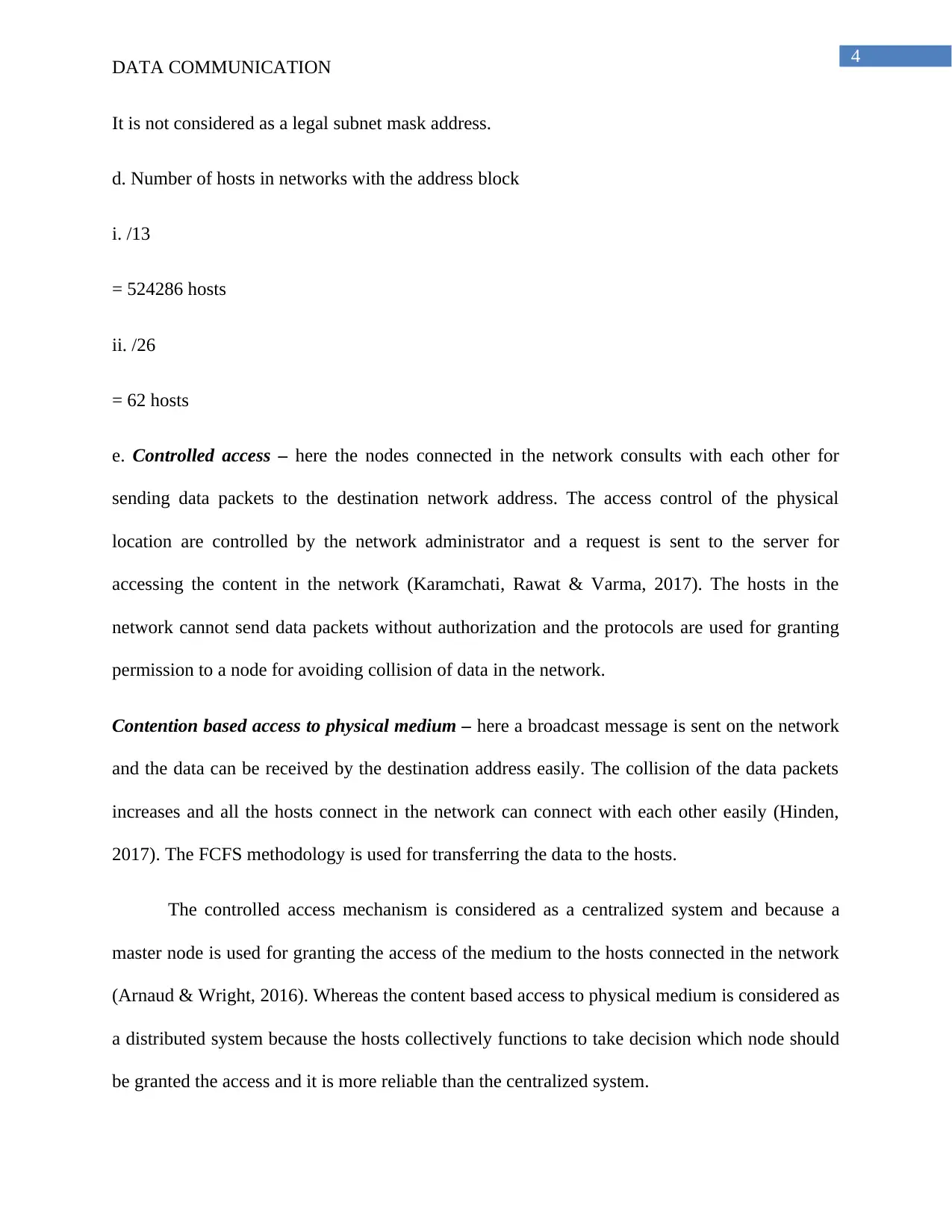
4
DATA COMMUNICATION
It is not considered as a legal subnet mask address.
d. Number of hosts in networks with the address block
i. /13
= 524286 hosts
ii. /26
= 62 hosts
e. Controlled access – here the nodes connected in the network consults with each other for
sending data packets to the destination network address. The access control of the physical
location are controlled by the network administrator and a request is sent to the server for
accessing the content in the network (Karamchati, Rawat & Varma, 2017). The hosts in the
network cannot send data packets without authorization and the protocols are used for granting
permission to a node for avoiding collision of data in the network.
Contention based access to physical medium – here a broadcast message is sent on the network
and the data can be received by the destination address easily. The collision of the data packets
increases and all the hosts connect in the network can connect with each other easily (Hinden,
2017). The FCFS methodology is used for transferring the data to the hosts.
The controlled access mechanism is considered as a centralized system and because a
master node is used for granting the access of the medium to the hosts connected in the network
(Arnaud & Wright, 2016). Whereas the content based access to physical medium is considered as
a distributed system because the hosts collectively functions to take decision which node should
be granted the access and it is more reliable than the centralized system.
DATA COMMUNICATION
It is not considered as a legal subnet mask address.
d. Number of hosts in networks with the address block
i. /13
= 524286 hosts
ii. /26
= 62 hosts
e. Controlled access – here the nodes connected in the network consults with each other for
sending data packets to the destination network address. The access control of the physical
location are controlled by the network administrator and a request is sent to the server for
accessing the content in the network (Karamchati, Rawat & Varma, 2017). The hosts in the
network cannot send data packets without authorization and the protocols are used for granting
permission to a node for avoiding collision of data in the network.
Contention based access to physical medium – here a broadcast message is sent on the network
and the data can be received by the destination address easily. The collision of the data packets
increases and all the hosts connect in the network can connect with each other easily (Hinden,
2017). The FCFS methodology is used for transferring the data to the hosts.
The controlled access mechanism is considered as a centralized system and because a
master node is used for granting the access of the medium to the hosts connected in the network
(Arnaud & Wright, 2016). Whereas the content based access to physical medium is considered as
a distributed system because the hosts collectively functions to take decision which node should
be granted the access and it is more reliable than the centralized system.
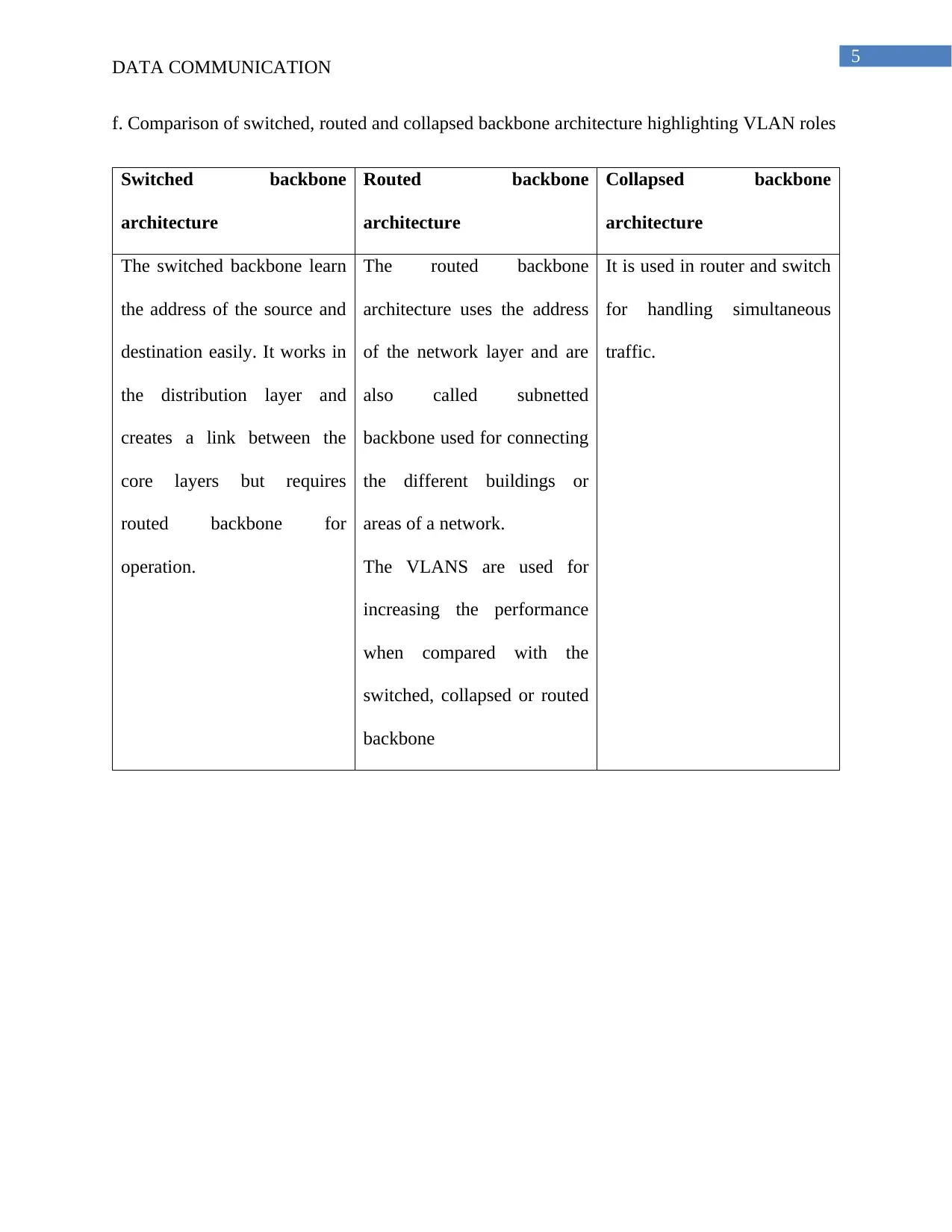
5
DATA COMMUNICATION
f. Comparison of switched, routed and collapsed backbone architecture highlighting VLAN roles
Switched backbone
architecture
Routed backbone
architecture
Collapsed backbone
architecture
The switched backbone learn
the address of the source and
destination easily. It works in
the distribution layer and
creates a link between the
core layers but requires
routed backbone for
operation.
The routed backbone
architecture uses the address
of the network layer and are
also called subnetted
backbone used for connecting
the different buildings or
areas of a network.
The VLANS are used for
increasing the performance
when compared with the
switched, collapsed or routed
backbone
It is used in router and switch
for handling simultaneous
traffic.
DATA COMMUNICATION
f. Comparison of switched, routed and collapsed backbone architecture highlighting VLAN roles
Switched backbone
architecture
Routed backbone
architecture
Collapsed backbone
architecture
The switched backbone learn
the address of the source and
destination easily. It works in
the distribution layer and
creates a link between the
core layers but requires
routed backbone for
operation.
The routed backbone
architecture uses the address
of the network layer and are
also called subnetted
backbone used for connecting
the different buildings or
areas of a network.
The VLANS are used for
increasing the performance
when compared with the
switched, collapsed or routed
backbone
It is used in router and switch
for handling simultaneous
traffic.
⊘ This is a preview!⊘
Do you want full access?
Subscribe today to unlock all pages.

Trusted by 1+ million students worldwide
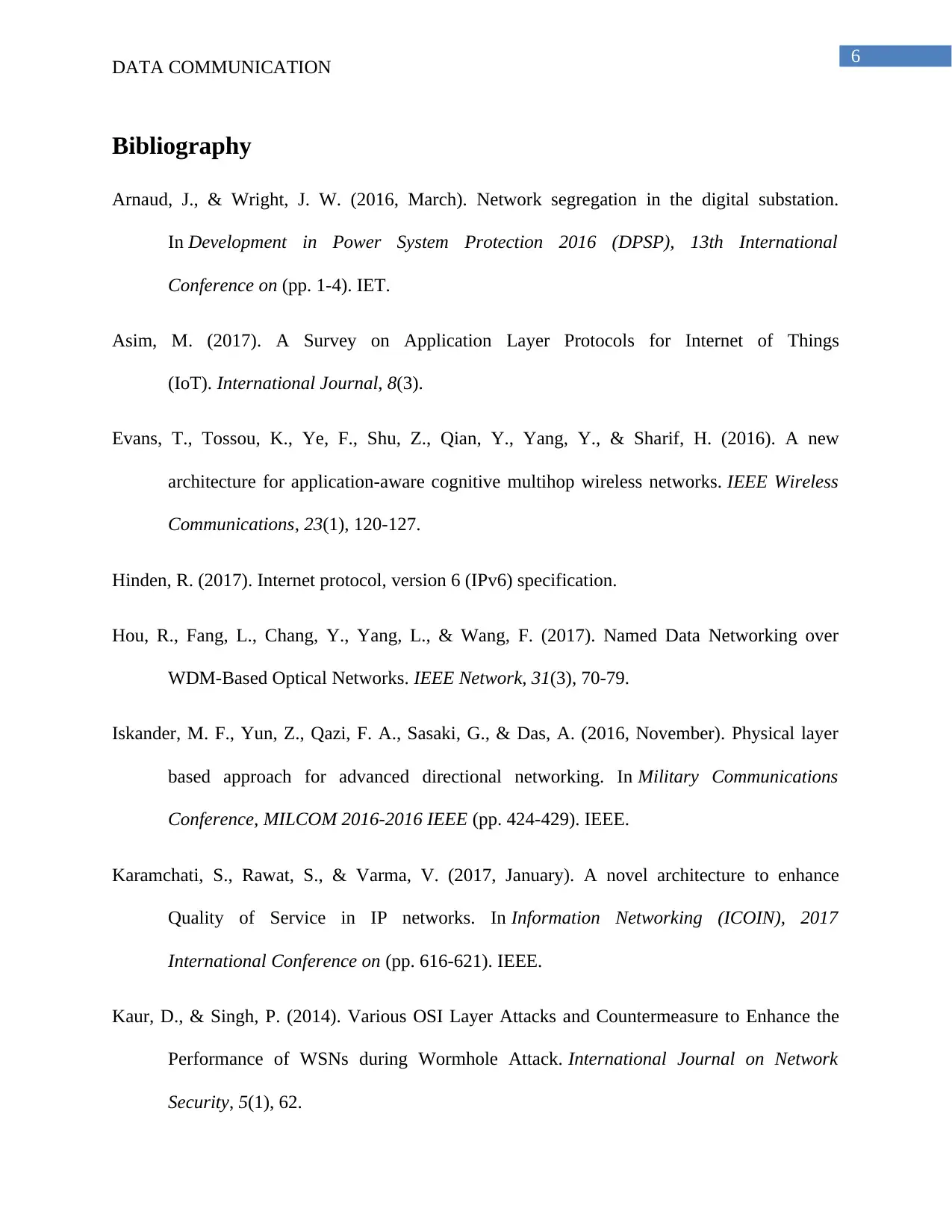
6
DATA COMMUNICATION
Bibliography
Arnaud, J., & Wright, J. W. (2016, March). Network segregation in the digital substation.
In Development in Power System Protection 2016 (DPSP), 13th International
Conference on (pp. 1-4). IET.
Asim, M. (2017). A Survey on Application Layer Protocols for Internet of Things
(IoT). International Journal, 8(3).
Evans, T., Tossou, K., Ye, F., Shu, Z., Qian, Y., Yang, Y., & Sharif, H. (2016). A new
architecture for application-aware cognitive multihop wireless networks. IEEE Wireless
Communications, 23(1), 120-127.
Hinden, R. (2017). Internet protocol, version 6 (IPv6) specification.
Hou, R., Fang, L., Chang, Y., Yang, L., & Wang, F. (2017). Named Data Networking over
WDM-Based Optical Networks. IEEE Network, 31(3), 70-79.
Iskander, M. F., Yun, Z., Qazi, F. A., Sasaki, G., & Das, A. (2016, November). Physical layer
based approach for advanced directional networking. In Military Communications
Conference, MILCOM 2016-2016 IEEE (pp. 424-429). IEEE.
Karamchati, S., Rawat, S., & Varma, V. (2017, January). A novel architecture to enhance
Quality of Service in IP networks. In Information Networking (ICOIN), 2017
International Conference on (pp. 616-621). IEEE.
Kaur, D., & Singh, P. (2014). Various OSI Layer Attacks and Countermeasure to Enhance the
Performance of WSNs during Wormhole Attack. International Journal on Network
Security, 5(1), 62.
DATA COMMUNICATION
Bibliography
Arnaud, J., & Wright, J. W. (2016, March). Network segregation in the digital substation.
In Development in Power System Protection 2016 (DPSP), 13th International
Conference on (pp. 1-4). IET.
Asim, M. (2017). A Survey on Application Layer Protocols for Internet of Things
(IoT). International Journal, 8(3).
Evans, T., Tossou, K., Ye, F., Shu, Z., Qian, Y., Yang, Y., & Sharif, H. (2016). A new
architecture for application-aware cognitive multihop wireless networks. IEEE Wireless
Communications, 23(1), 120-127.
Hinden, R. (2017). Internet protocol, version 6 (IPv6) specification.
Hou, R., Fang, L., Chang, Y., Yang, L., & Wang, F. (2017). Named Data Networking over
WDM-Based Optical Networks. IEEE Network, 31(3), 70-79.
Iskander, M. F., Yun, Z., Qazi, F. A., Sasaki, G., & Das, A. (2016, November). Physical layer
based approach for advanced directional networking. In Military Communications
Conference, MILCOM 2016-2016 IEEE (pp. 424-429). IEEE.
Karamchati, S., Rawat, S., & Varma, V. (2017, January). A novel architecture to enhance
Quality of Service in IP networks. In Information Networking (ICOIN), 2017
International Conference on (pp. 616-621). IEEE.
Kaur, D., & Singh, P. (2014). Various OSI Layer Attacks and Countermeasure to Enhance the
Performance of WSNs during Wormhole Attack. International Journal on Network
Security, 5(1), 62.
Paraphrase This Document
Need a fresh take? Get an instant paraphrase of this document with our AI Paraphraser

7
DATA COMMUNICATION
Liu, Y., Liu, A., Li, Y., Li, Z., Choi, Y. J., Sekiya, H., & Li, J. (2017). APMD: A fast data
transmission protocol with reliability guarantee for pervasive sensing data
communication. Pervasive and Mobile Computing, 41, 413-435.
Marinos, I., Watson, R. N., & Handley, M. (2014, August). Network stack specialization for
performance. In ACM SIGCOMM Computer Communication Review (Vol. 44, No. 4, pp.
175-186). ACM.
McNamara, J. E. (2014). Technical aspects of data communication. Digital Press.
Mekonnen, K. A., Tangdiongga, E., & Koonen, A. M. J. (2015, November). Reconfigurable
optical backbone network architecture for indoor wireless communication.
In Proceedings of the 20th Annual Symposium of the IEEE Photonics Benelux
Chapter (Vol. 26, p. 27).
Mukherjee, A. (2015). Physical-layer security in the internet of things: Sensing and
communication confidentiality under resource constraints. Proceedings of the
IEEE, 103(10), 1747-1761.
Raza, S., Duquennoy, S., Höglund, J., Roedig, U., & Voigt, T. (2014). Secure communication for
the Internet of Things—a comparison of link‐layer security and IPsec for
6LoWPAN. Security and Communication Networks, 7(12), 2654-2668.
Schlechtendahl, J., Kretschmer, F., Lechler, A., & Verl, A. (2014). Communication mechanisms
for cloud based machine controls. Procedia CIRP, 17, 830-834.
Wabnitz, S., & Eggleton, B. J. (Eds.). (2015). All-optical signal processing: data communication
and storage applications(Vol. 194). Springer.
DATA COMMUNICATION
Liu, Y., Liu, A., Li, Y., Li, Z., Choi, Y. J., Sekiya, H., & Li, J. (2017). APMD: A fast data
transmission protocol with reliability guarantee for pervasive sensing data
communication. Pervasive and Mobile Computing, 41, 413-435.
Marinos, I., Watson, R. N., & Handley, M. (2014, August). Network stack specialization for
performance. In ACM SIGCOMM Computer Communication Review (Vol. 44, No. 4, pp.
175-186). ACM.
McNamara, J. E. (2014). Technical aspects of data communication. Digital Press.
Mekonnen, K. A., Tangdiongga, E., & Koonen, A. M. J. (2015, November). Reconfigurable
optical backbone network architecture for indoor wireless communication.
In Proceedings of the 20th Annual Symposium of the IEEE Photonics Benelux
Chapter (Vol. 26, p. 27).
Mukherjee, A. (2015). Physical-layer security in the internet of things: Sensing and
communication confidentiality under resource constraints. Proceedings of the
IEEE, 103(10), 1747-1761.
Raza, S., Duquennoy, S., Höglund, J., Roedig, U., & Voigt, T. (2014). Secure communication for
the Internet of Things—a comparison of link‐layer security and IPsec for
6LoWPAN. Security and Communication Networks, 7(12), 2654-2668.
Schlechtendahl, J., Kretschmer, F., Lechler, A., & Verl, A. (2014). Communication mechanisms
for cloud based machine controls. Procedia CIRP, 17, 830-834.
Wabnitz, S., & Eggleton, B. J. (Eds.). (2015). All-optical signal processing: data communication
and storage applications(Vol. 194). Springer.

8
DATA COMMUNICATION
DATA COMMUNICATION
⊘ This is a preview!⊘
Do you want full access?
Subscribe today to unlock all pages.

Trusted by 1+ million students worldwide
1 out of 9
Related Documents
Your All-in-One AI-Powered Toolkit for Academic Success.
+13062052269
info@desklib.com
Available 24*7 on WhatsApp / Email
![[object Object]](/_next/static/media/star-bottom.7253800d.svg)
Unlock your academic potential
Copyright © 2020–2025 A2Z Services. All Rights Reserved. Developed and managed by ZUCOL.





